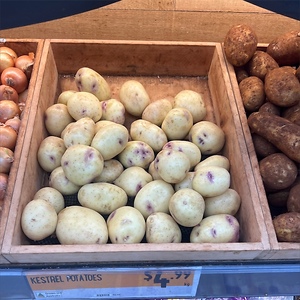


Kestrel Potatoes
Estimated Inventory, lb : 0
Description/Taste
Kestrel potatoes are medium to large in size and are oval, oblong, and elongated in shape, averaging 6-12 centimeters in length. This variety has a fairly uniform shape, and the skin is thin, smooth, and pale cream to almost white in color. The skin is also decorated with brown spots and a few shallow eyes that are spotted with a vibrant shade of purple. The ‘rose’ end or end with the most eyes will sometimes appear to be entirely brushed with purple. The flesh is a creamy white with a firm, crisp texture. When cooked, Kestrel potatoes have a rich, earthy, and buttery flavor.
Seasons/Availability
Kestrel potatoes are available year-round, with peak season in the late summer.
Current Facts
Kestrel potatoes, botanically classified as Solanum tuberosum, are a hybrid white potato variety and are members of the Solanaceae or nightshade family along with eggplant, tomatoes, and peppers. A cross between a cara potato and an un-named variety of Solanum vernei, the Scottish potato was developed by one of the potato industry’s renowned breeders, Dr. Jack Dunnett, who is considered to be one of the pioneers of modern potato breeding. Kestrel potatoes are considered second early potatoes, so-called for their planting schedule, and can be used as both young, new potatoes or harvested later and larger, for use as a main crop. They are appealing to both home and commercial growers because of their high disease, pest resistance, good yields, and versatility in the kitchen.
Nutritional Value
Kestrel potatoes are high in dietary fiber, iron, and potassium and are a good source of vitamin C, vitamins B1, B3, and B6, which are essential vitamins, and folic acid. They also contain phosphorus, magnesium, and the antioxidant anthocyanin, which is responsible for the purple color near the eyes.
Applications
Kestrel potatoes are best suited for cooked applications such as baking, roasting, boiling, or frying and can be cooked with or without the skin. When mashed, they have a smooth texture and creamy consistency. They can be used for making chips, French fries, or for wedging or dicing and sautéing. Kestrel potatoes are not well-suited for use as salad potatoes, unlike new potatoes. Kestrel potatoes pair well with herbs and spices such as parsley, sage, dill, ginger, mustard seeds, cumin, turmeric, and coriander, chives, fennel, garlic, yogurt, pancetta, smoked salmon, parmesan, crème fraiche, cauliflower, and red onion. Do not store Kestrel potatoes in the refrigerator, as it will encourage the natural breakdown of sugars in the flesh. They will keep at room temperature up to two weeks when stored in a cool, dry, and dark place.
Ethnic/Cultural Info
Potatoes have been grown in Scotland since the early 18th century and were first grown in the county of Stirling. Then in 1784, the Royal Horticultural and Agricultural Society of Scotland was founded and became a pioneer in potato breeding and growing. Today Scotland is highly regarded as one of the top seed potato producers in Europe and maintains strict regulations and control over cultivation to ensure that quality and standards are met.
Geography/History
Kestrel potatoes were developed in 1992 by plant breeder Dr. Jack Dunnett of Caithness Potatoes in northern Scotland. Today Kestrel potatoes are primarily grown in the United Kingdom, Australia, and New Zealand and can be found at specialty grocers and markets.
Recipe Ideas
Recipes that include Kestrel Potatoes. One
| Kestrel Potato |
|
Potato & Cauliflower Soup |








